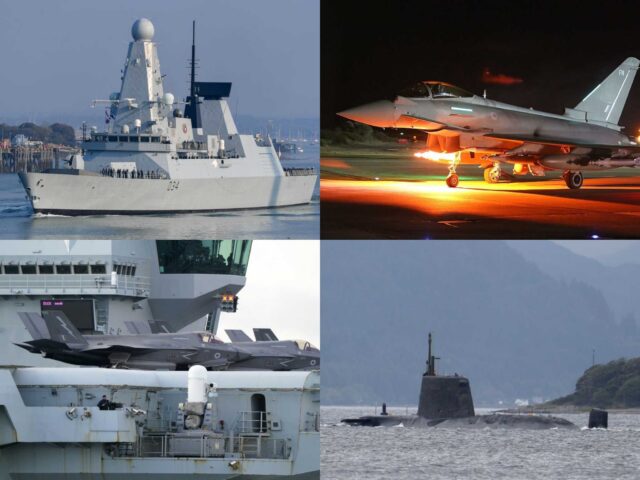The United Kingdom “won’t hesitate” to take “direct action” against Houthis in Yemen its Defence Secretary has said, as the nation’s military reportedly prepares for strikes.
Attacks on global shipping passing through the Red Sea by Islamist terrorists are being felt in the West as delays mount and the cost of imports rise to cover soaring insurance costs and the United Kingdom is preparing to join the United States in launching direct strikes, it is claimed. UK newspaper of record The Times reports the country is preparing to launch airstrikes in Yemen with the U.S., and while “no decisions have yet been made”, “planning is underway”, a spokesman is reported to have said.
Iran-backed Houthis, who are a faction of Shiite Islamist fighters in Yemen, have been attacking ships in an increasingly determined way since Hamas launched its deadly terror attack against Israel last year. While the attacks were initially portrayed as being targeted against Israeli shipping, dozens of strikes later they appear to be more broadly anti-Western, with many ships attacked being linked to the United Kingdom.
Houthis have also attempted to get directly involved with the Hamas-Israel war, launching ballistic missiles.
The British Defence Secretary Grant Shapps noted insurance premiums paid by commercial ships attempting to transit the Red Sea — an important strategic waterway that cuts over a week off the voyage of a vessel carrying goods or oil from the East to Europe or the American East Coast — had increased “tenfold since early December”. These costs, and the risk of losing a ship to attack are sufficiently great that many of the world’s largest carriers are now avoiding the area altogether, piling on costs and delays to global trade.
Progress on Tackling Inflation May be Wiped Out by Houthi Attacks on Cargo Shipshttps://t.co/3IU9rHzGBz
— Breitbart London (@BreitbartLondon) December 26, 2023
Writing in The Daily Telegraph on Monday, Shapps said because of the seriousness of the situation and the risk of “miscalculation and escalation” from allowing Houthi strikes to continue unchallenged, Western retaliatory strikes may be on the horizon. He wrote:
We need to stand firm with our allies… we are willing to take direct action, and we won’t hesitate to take further action to deter threats to freedom of navigation in the Red Sea.
The Houthis should be under no misunderstanding: we are committed to holding malign actors accountable for unlawful seizures and attacks.
Shapps emphasised that a precedent risked being set: the Red Sea isn’t the only critical maritime chokepoint worldwide, and a sign of weakness here could imperil Western seaborne trade elsewhere.
A British government spokesman cited by The Times underlined that work was going on behind the scenes for these apparently pending strikes against land targets in Yemen. They are reported to have said: “Houthi attacks are unacceptable and destabilising. As you would expect, while planning is underway for a range of scenarios, no decisions have yet been made and we continue to pursue all diplomatic routes.”
The United States, for its own part, spoke in terms of self-defence and not wanting to escalate conflict in the region. National Security spokesman John Kirby said: “We’re going to do what we have to do to protect shipping… we’re going to act in self-defence going forward”.
Specifics are in short supply, but the reality of what equipment the United Kingdom has that is capable of launching such strikes, and that is available to deploy, suggests if the plan goes ahead it will take a certain form.
Although the exact whereabouts of submarines is not generally public knowledge, it has been reported by insider blog Navy Lookout that availability of the Royal Navy’s (RN) attack submarines has been extremely poor this year, with some days, including recently, where not a single boat was at sea. This may be still the case now, and so one of the Navy’s most potent land-attack assets may be nowhere near this new theatre of operations.
The high-readiness carrier HMS Queen Elizabeth now has a working air wing and has even used it in anger, striking Islamic State targets from the Mediterranean last year. But that too is far from the Red Sea, presently in port in Portsmouth, England.
For Import-Dependent West, Costs Will Add Up As Long as Houthis Keep Red Sea Closed https://t.co/jaKab0GdSJ
— Breitbart London (@BreitbartLondon) December 21, 2023
HMS Diamond is in the area, but is an air-warfare destroyer with no officially disclosed land-attack capacity. It is being used in a defensive role, and recently shot down a Houthi drone harassing shipping over the Red Sea, possibly the first RN air ‘kill’ in anger in decades.
Several Royal Naval warships are due to receive the new Norwegian-designed land attack Naval Strike Missile this year, but so far only one ship is known to have had the weapon packs installed, returning to its home base from Norway just before Christmas.
Realistically, this leaves the RAF’s Storm Shadow Missile-equipped Eurofighter Typhoons, although at nearly 1,500 miles away from Yemen in their base at Akrotiri, Cyprus in the eastern Mediterranean it is unclear what sustained pressure they could bring to bear without operating from a forward position like Al Musannah in Oman. The Storm Shadow Missile, which costs around £2 million a go is presently in high demand beyond the needs of taking out Iran-backed Houthi Shiite militas in Yemen, as large numbers of the missile are being used by Ukraine, donated by the UK and France.
Designed to attack and destroy buried and highly armoured targets, the sophisticated missile has been at the centre of several of Ukraine’s most successful strikes in recent months, including the hammering of Russia’s Black Sea Fleet headquarters building in Sevastopol, Ukraine, and the destruction of a major Russian warship as it lay alongside.

COMMENTS
Please let us know if you're having issues with commenting.